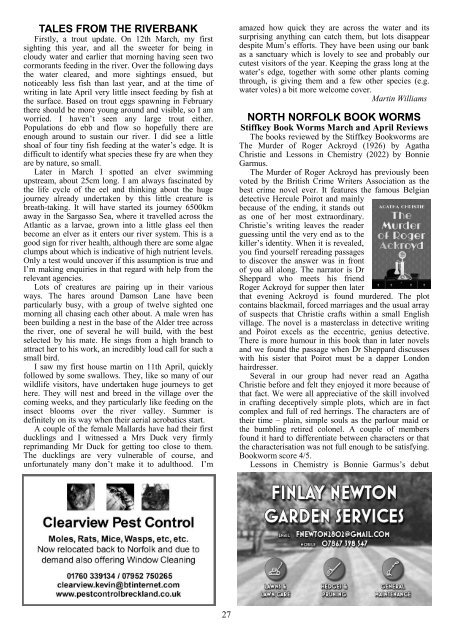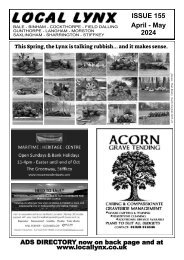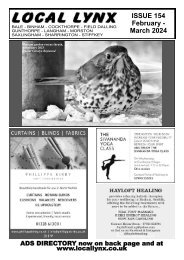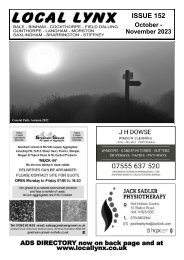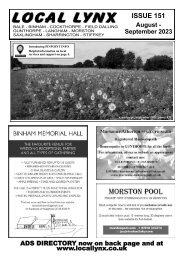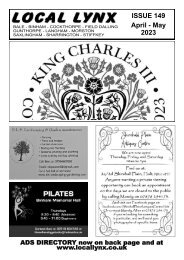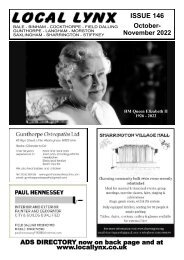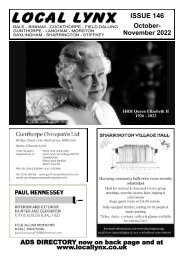Local Lynx No. 150 - June/July 2023
The community newspaper for 10 North Norfolk villages
The community newspaper for 10 North Norfolk villages
You also want an ePaper? Increase the reach of your titles
YUMPU automatically turns print PDFs into web optimized ePapers that Google loves.
TALES FROM THE RIVERBANK<br />
Firstly, a trout update. On 12th March, my first<br />
sighting this year, and all the sweeter for being in<br />
cloudy water and earlier that morning having seen two<br />
cormorants feeding in the river. Over the following days<br />
the water cleared, and more sightings ensued, but<br />
noticeably less fish than last year, and at the time of<br />
writing in late April very little insect feeding by fish at<br />
the surface. Based on trout eggs spawning in February<br />
there should be more young around and visible, so I am<br />
worried. I haven’t seen any large trout either.<br />
Populations do ebb and flow so hopefully there are<br />
enough around to sustain our river. I did see a little<br />
shoal of four tiny fish feeding at the water’s edge. It is<br />
difficult to identify what species these fry are when they<br />
are by nature, so small.<br />
Later in March I spotted an elver swimming<br />
upstream, about 25cm long. I am always fascinated by<br />
the life cycle of the eel and thinking about the huge<br />
journey already undertaken by this little creature is<br />
breath-taking. It will have started its journey 6500km<br />
away in the Sargasso Sea, where it travelled across the<br />
Atlantic as a larvae, grown into a little glass eel then<br />
become an elver as it enters our river system. This is a<br />
good sign for river health, although there are some algae<br />
clumps about which is indicative of high nutrient levels.<br />
Only a test would uncover if this assumption is true and<br />
I’m making enquiries in that regard with help from the<br />
relevant agencies.<br />
Lots of creatures are pairing up in their various<br />
ways. The hares around Damson Lane have been<br />
particularly busy, with a group of twelve sighted one<br />
morning all chasing each other about. A male wren has<br />
been building a nest in the base of the Alder tree across<br />
the river, one of several he will build, with the best<br />
selected by his mate. He sings from a high branch to<br />
attract her to his work, an incredibly loud call for such a<br />
small bird.<br />
I saw my first house martin on 11th April, quickly<br />
followed by some swallows. They, like so many of our<br />
wildlife visitors, have undertaken huge journeys to get<br />
here. They will nest and breed in the village over the<br />
coming weeks, and they particularly like feeding on the<br />
insect blooms over the river valley. Summer is<br />
definitely on its way when their aerial acrobatics start.<br />
A couple of the female Mallards have had their first<br />
ducklings and I witnessed a Mrs Duck very firmly<br />
reprimanding Mr Duck for getting too close to them.<br />
The ducklings are very vulnerable of course, and<br />
unfortunately many don’t make it to adulthood. I’m<br />
amazed how quick they are across the water and its<br />
surprising anything can catch them, but lots disappear<br />
despite Mum’s efforts. They have been using our bank<br />
as a sanctuary which is lovely to see and probably our<br />
cutest visitors of the year. Keeping the grass long at the<br />
water’s edge, together with some other plants coming<br />
through, is giving them and a few other species (e.g.<br />
water voles) a bit more welcome cover.<br />
Martin Williams<br />
NORTH NORFOLK BOOK WORMS<br />
Stiffkey Book Worms March and April Reviews<br />
The books reviewed by the Stiffkey Bookworms are<br />
The Murder of Roger Ackroyd (1926) by Agatha<br />
Christie and Lessons in Chemistry (2022) by Bonnie<br />
Garmus.<br />
The Murder of Roger Ackroyd has previously been<br />
voted by the British Crime Writers Association as the<br />
best crime novel ever. It features the famous Belgian<br />
detective Hercule Poirot and mainly<br />
because of the ending, it stands out<br />
as one of her most extraordinary.<br />
Christie’s writing leaves the reader<br />
guessing until the very end as to the<br />
killer’s identity. When it is revealed,<br />
you find yourself rereading passages<br />
to discover the answer was in front<br />
of you all along. The narrator is Dr<br />
Sheppard who meets his friend<br />
Roger Ackroyd for supper then later<br />
that evening Ackroyd is found murdered. The plot<br />
contains blackmail, forced marriages and the usual array<br />
of suspects that Christie crafts within a small English<br />
village. The novel is a masterclass in detective writing<br />
and Poirot excels as the eccentric, genius detective.<br />
There is more humour in this book than in later novels<br />
and we found the passage when Dr Sheppard discusses<br />
with his sister that Poirot must be a dapper London<br />
hairdresser.<br />
Several in our group had never read an Agatha<br />
Christie before and felt they enjoyed it more because of<br />
that fact. We were all appreciative of the skill involved<br />
in crafting deceptively simple plots, which are in fact<br />
complex and full of red herrings. The characters are of<br />
their time – plain, simple souls as the parlour maid or<br />
the bumbling retired colonel. A couple of members<br />
found it hard to differentiate between characters or that<br />
the characterisation was not full enough to be satisfying.<br />
Bookworm score 4/5.<br />
Lessons in Chemistry is Bonnie Garmus’s debut<br />
27


